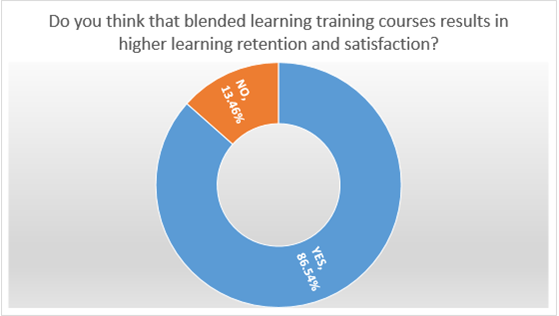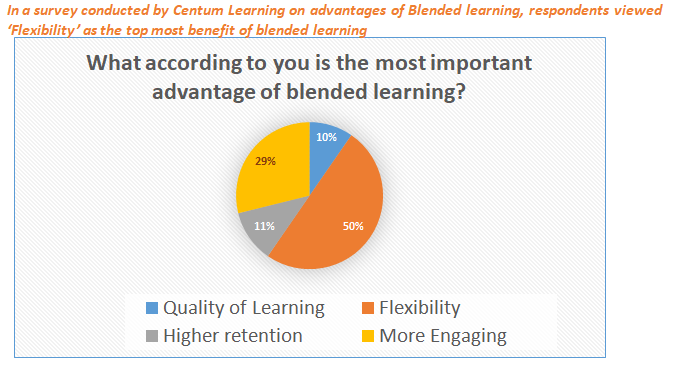Understanding the Merits of Blended Learning
1.What are the challenges faced by blended learning during pandemic?
The impact of digitalization in the learning space was quite evident even before the pandemic with the rise of online learning approach. However, the need for online learning approach intensified after the first wave, posing varied challenges to both enterprises and learners.
‘Blended Learning is an approach that incorporates both online and face-to-face learning’.Many studies reveal that blended learning has the potential to provide a fulfilling and rich learning environment to the learners.
The development of Information and Communication Technologies (ICT) has led to the evolution of a ‘digitized’ world, especially during the pandemic as it became a necessity, thereby forcing varied institutions to shift their operations and processes fully dependent on technology.Online Learning system gained momentum during the pandemic as it was the ‘need of the hour’ and inevitable.
However, soon the challenges of only online mode of learning were realized, like low engagement and technology fatigue. Also face to face interaction was not possible during the pandemic. Thus to replace only online mode of training,organizations, trainers and learners started looking for innovative approaches to blended learning.For instance, smaller groups activities, individual experiential exercises, experiential exercises with members outside training cohort, and the likes were incorporated and sharing learning experiences with the entire class became key features of learning methodology.
Learning & Development industry also felt that only face to face mode of learning also has some limitations. For example the class composition was not as diverse as it was possible in online mode as participants could join from remote corners of the world and from different countries and cultures which enriched the experience sharing and learning discussions. Also the cost of conducting in-presence learning was also very high.
Therefore, even when the restrictions imposed during the pandemic were relaxed, the preference for blended learning increased manifolds.
The challenges of using blended approach that was experienced during the pandemic were:
-Lack of preparation on different aspects like adaptive content, innovative technology, and infrastructure by both enterprises and learners.
-Readiness of the learners to adopt innovative technologies
-Pedagogies of learning changed during the pandemic and the onus of learning shifted from the trainer to the learner which required fast adaptation from the learner and the trainer
-Learner expectations from training program changed
-Personal touch with the cohort having similar interests was missing as the experiential learning was restricted due to the pandemic
It took more time and efforts to gain familiarity with the innovations that were to be incorporated. However, it was realized that blended learning approach brings in the best of both online and face to face learning approaches.

Dr.Geetika Malik Chandra, Lead, Content(Research & Analysis), Centum Learning Limited
2.How effective is blended learning in a corporate structure?
With the advent of hybrid work systems in place post pandemic and digital transformation sweeping through enterprises, blended learning is becoming a growing trend in the corporates too.
In a world where work dynamics are changing at a rapid pace, the fastest learner wins, and the organizations which adapt, innovate and are agile will certainly succeed. ‘Blended Learning Training is the need of the hour so as to keep the learning culture alive in organizations, making employees future ready’. In a survey conducted by Centum Learning reveals that 86.54% of the participants are of the opinion that blended learning training courses results in higher learning retention and satisfaction.

As corporates move up in the digital era, there is a strong appetite for constant skilling and reskilling of employees.Considering skill development for current employees to close skill gaps is a better, faster and cost-effective solution as against hiring new employees. This necessitates inculcating blended learning approach in the corporate structure to remain effective.

Therefore, imbibing a blended learning approach in the corporate structure ensures
-Flexible Learning which is not just imposed, but convenient for the employees to undergo at their pace
-Engaged learning
-Expanded reach
-Cost effective learning
-Better Feedback
3.Implementing blended learning in a Corporate setting: impacts and difficulties
Blended learning is an effective and low-risk strategy for addressing the challenges posed by the transformational changes owing to rapid technological advancements. However, implementing blended learning brings with it certain challenges such as
-Technical
-Organizational and
-Content delivery
Technical challenges doesn’t really entail just getting technology to work on networks, but instead it involves using and supporting appropriate technologies to ensure the success of the program.
From the organization perspective,blended learning is considered the apt way for learning initiatives, however there is lack of understanding that it is a complex process which requires transformation in various processes like the role of the facilitator, learners progress journey etc. Also while the learning technologies are blended into the course,much of the focus is on the technology implementation whereas, often the content creators are left with too little time and funds to make a successful program.
To counter these challenges, a holistic approach needs to be followed to understand the complexity of blended approach. This includes:
-Researching on different ICTs for their suitability and integration with face-to-face environments
-Identify the characteristics of optimal blends for learning
-Determining varied pedagogies supporting blended approach
-Ensuring adequate support to the instructors following this mode of learning
4.What is the vital role of technology in blended learning?
Blended learning involves a thoughtful integration of face-to-face and online learning approach along with appropriate technologies.Technology plays a vital role in
-Facilitating quick knowledge transfer by enabling learners to access the course materials and assignments easily.
-Helping learners in adjusting their learning progress,
-Bridging the social interaction gap, and
-Fosters collaboration amongst each other
In conclusion, blended learning is emerging as an effective approach integrating technology with varied pedagogies to keep the learning culture alive with the most appropriate blend.
Dr. Tripti Singh, Chief Learning officer, Centum Learning Limited
Dr. Tripti Singh is a Doctorate from XLRI School of Management, Jamshedpur and Masters in HR&IR from Lucknow University.She specializes in HR & Organizational Behavior and Transformational Leadership Area. .
Dr. Geetika Malik Chandra, Lead Content(Research &Analysis), Centum Learning Limited
Dr. Geetika Malik Chandra holds Doctorate degree from the prestigious FMS (Faculty of Management studies), University of Delhi. She has received Highly commended outstanding Doctoral Research Award 2020, in the HR category from Emerald/EFMD (UK) in October 2020.
The impact of digitalization in the learning space was quite evident even before the pandemic with the rise of online learning approach. However, the need for online learning approach intensified after the first wave, posing varied challenges to both enterprises and learners.
‘Blended Learning is an approach that incorporates both online and face-to-face learning’.Many studies reveal that blended learning has the potential to provide a fulfilling and rich learning environment to the learners.
The development of Information and Communication Technologies (ICT) has led to the evolution of a ‘digitized’ world, especially during the pandemic as it became a necessity, thereby forcing varied institutions to shift their operations and processes fully dependent on technology.Online Learning system gained momentum during the pandemic as it was the ‘need of the hour’ and inevitable.
However, soon the challenges of only online mode of learning were realized, like low engagement and technology fatigue. Also face to face interaction was not possible during the pandemic. Thus to replace only online mode of training,organizations, trainers and learners started looking for innovative approaches to blended learning.For instance, smaller groups activities, individual experiential exercises, experiential exercises with members outside training cohort, and the likes were incorporated and sharing learning experiences with the entire class became key features of learning methodology.
Learning & Development industry also felt that only face to face mode of learning also has some limitations. For example the class composition was not as diverse as it was possible in online mode as participants could join from remote corners of the world and from different countries and cultures which enriched the experience sharing and learning discussions. Also the cost of conducting in-presence learning was also very high.
Therefore, even when the restrictions imposed during the pandemic were relaxed, the preference for blended learning increased manifolds.
The challenges of using blended approach that was experienced during the pandemic were:
-Lack of preparation on different aspects like adaptive content, innovative technology, and infrastructure by both enterprises and learners.
-Readiness of the learners to adopt innovative technologies
-Pedagogies of learning changed during the pandemic and the onus of learning shifted from the trainer to the learner which required fast adaptation from the learner and the trainer
-Learner expectations from training program changed
-Personal touch with the cohort having similar interests was missing as the experiential learning was restricted due to the pandemic
It took more time and efforts to gain familiarity with the innovations that were to be incorporated. However, it was realized that blended learning approach brings in the best of both online and face to face learning approaches.
Dr.Geetika Malik Chandra, Lead, Content(Research & Analysis), Centum Learning Limited
2.How effective is blended learning in a corporate structure?
With the advent of hybrid work systems in place post pandemic and digital transformation sweeping through enterprises, blended learning is becoming a growing trend in the corporates too.
In a world where work dynamics are changing at a rapid pace, the fastest learner wins, and the organizations which adapt, innovate and are agile will certainly succeed. ‘Blended Learning Training is the need of the hour so as to keep the learning culture alive in organizations, making employees future ready’. In a survey conducted by Centum Learning reveals that 86.54% of the participants are of the opinion that blended learning training courses results in higher learning retention and satisfaction.
As corporates move up in the digital era, there is a strong appetite for constant skilling and reskilling of employees.Considering skill development for current employees to close skill gaps is a better, faster and cost-effective solution as against hiring new employees. This necessitates inculcating blended learning approach in the corporate structure to remain effective.
Therefore, imbibing a blended learning approach in the corporate structure ensures
-Flexible Learning which is not just imposed, but convenient for the employees to undergo at their pace
-Engaged learning
-Expanded reach
-Cost effective learning
-Better Feedback
3.Implementing blended learning in a Corporate setting: impacts and difficulties
Blended learning is an effective and low-risk strategy for addressing the challenges posed by the transformational changes owing to rapid technological advancements. However, implementing blended learning brings with it certain challenges such as
-Technical
-Organizational and
-Content delivery
Technical challenges doesn’t really entail just getting technology to work on networks, but instead it involves using and supporting appropriate technologies to ensure the success of the program.
From the organization perspective,blended learning is considered the apt way for learning initiatives, however there is lack of understanding that it is a complex process which requires transformation in various processes like the role of the facilitator, learners progress journey etc. Also while the learning technologies are blended into the course,much of the focus is on the technology implementation whereas, often the content creators are left with too little time and funds to make a successful program.
To counter these challenges, a holistic approach needs to be followed to understand the complexity of blended approach. This includes:
-Researching on different ICTs for their suitability and integration with face-to-face environments
-Identify the characteristics of optimal blends for learning
-Determining varied pedagogies supporting blended approach
-Ensuring adequate support to the instructors following this mode of learning
4.What is the vital role of technology in blended learning?
Blended learning involves a thoughtful integration of face-to-face and online learning approach along with appropriate technologies.Technology plays a vital role in
-Facilitating quick knowledge transfer by enabling learners to access the course materials and assignments easily.
-Helping learners in adjusting their learning progress,
-Bridging the social interaction gap, and
-Fosters collaboration amongst each other
In conclusion, blended learning is emerging as an effective approach integrating technology with varied pedagogies to keep the learning culture alive with the most appropriate blend.
Dr. Tripti Singh, Chief Learning officer, Centum Learning Limited
Dr. Tripti Singh is a Doctorate from XLRI School of Management, Jamshedpur and Masters in HR&IR from Lucknow University.She specializes in HR & Organizational Behavior and Transformational Leadership Area. .
Dr. Geetika Malik Chandra, Lead Content(Research &Analysis), Centum Learning Limited
Dr. Geetika Malik Chandra holds Doctorate degree from the prestigious FMS (Faculty of Management studies), University of Delhi. She has received Highly commended outstanding Doctoral Research Award 2020, in the HR category from Emerald/EFMD (UK) in October 2020.
